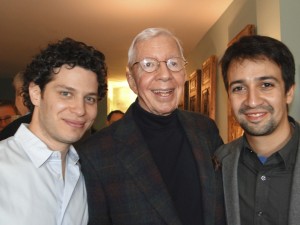Next week Justice Antonin Scalia will be delivering the Hugo Black Lecture at Wesleyan. It’s been a long time since we’ve welcomed a Supreme Court Justice to Middletown. Justice Harry Blackmun visited the campus in 1993, giving the second lecture in this series. We’ve invited others, but given the busy schedule of the Court, we have not been able to arrange a visit. When Justice Scalia accepted the invitation, he said that he had heard positive feedback about the lecture series and Wesleyan from his former law clerk, Lawrence Lessig, who spoke here a couple of years ago.
I was very impressed by Justice Scalia’s comment. After all, everyone knows how far to the right Justice Scalia is, and Professor Lessig is pretty far along the opposite end of the political spectrum. It seemed to me a very good thing that these two men were in conversation about Wesleyan, and that Justice Scalia seemed to have respect and affection for a legal theorist with whom he undoubtedly differs on a slew of important issues.
Predictably, some faculty and students have objected to inviting to campus a public figure with whom they fiercely disagree. Less predictably, hundreds of Wesleyan students lined up to get tickets to the event (I wish we had more seats!). I suspect that this doesn’t mean they want to hear views they will find congenial. They want to hear a powerful advocate for a point of view that is having a decisive impact on the country. They want argument and disagreement — not an echo of their own thoughts. They want an educational environment.
Although as a citizen I have frequently found myself opposed to Justice Scalia’s views, as a professor and college president I am eager to hear them expressed in the setting of a public lecture. We need more vigorous debate on campus about political issues, and debate that does not just feature different views from the same sector of the ideological spectrum. We live in very polarized times, when differences of opinion quickly give rise to personal attacks on the one hand, and to retreats into like-minded groups, on the other. Sure, people may at first seek out others who share their strongly held views, but that kind of ideological and cognitive reinforcement is anti-educational.
Tucker Andersen ’63 is on the Wesleyan Board of Trustees. When I asked him to join, he expressed some hesitation because he did not know if his libertarian views and free-market advocacy would be welcome. He has been happy to support the university generously with his time and resources, and has often shared ideas with me on how to achieve our common goals for Wesleyan. But he was concerned that his political perspectives would create a distraction for the board as it pursued those goals. Despite the fact (maybe because of the fact) that we pretty frequently disagree on political matters, I told Tucker that we needed contrarian perspectives on the board. He has been a great board member, and I continue to benefit from his thoughtful point of view.
One of the questions Tucker asks me from time to time is how we can achieve more political diversity on campus. I haven’t found a good answer for him. It seems to many conservative observers that we are pretty homogeneous politically. We don’t seek out historians, critics, economists or scientists of one political persuasion or another, but we should be more aware of prejudices that might lead us to hire people whose political views reinforce our own. A certain amount of political prejudice is part of the culture of the campus — many take for granted that with education comes political commitment associated with the Left. This is a mistake. If we don’t recognize this mistake and try to correct it, we ourselves will be guilty of intolerance and anti-intellectualism. We will have no ground to stand on when faced with the arrogant, pseudo-populist ignorance we’ve been seeing recently on the campaign trail.
I often describe Wesleyan as representing the best in progressive liberal arts education. To truly be progressive, to develop programs that lead other institutions to learn from our example, we need to hear thoughtful voices from a variety of political perspectives. Although I consider myself a person of the Left, it is a serious error to think that all educated points of view will come from those who share our particular vision of critique, of progress, or of social justice. We should not welcome those who cannot tolerate difference, those whose views close down thinking and social interaction. But we should welcome dissent. Making the conservative or libertarian case at a liberal arts university like ours is a tough thing to do, and I admire those who try to do so.
By bringing intelligent conservative discourse to campus, we will increase our capacity to combat the idiot wind of know-nothing anti-intellectualism that is all too prevalent in our political culture. I am hopeful that Justice Scalia’s lecture and discussion will contribute to this capacity.



